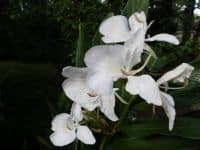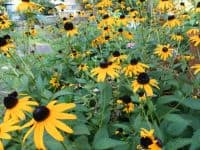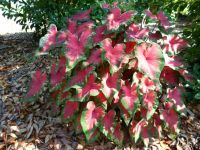Hot August Flowers

For sunny beds or containers, choose periwinkle, melampodium, blue daze, purslane, portulaca, pentas, torenia, perennial verbena, salvias, sun-tolerant coleus, cleome, butterfly weed, hard hibiscus (mallow), salvia, lantana, zinnia, marigold, abelmoschus, globe amaranth, cosmos, balsam, celosia, scaevola, Mexican heather, plumbago, black-eyed susan, purple cone flower and vinca . For shady and partly- shady beds and containers, choose impatiens, begonias and coleus. Continue deadheading old flowers to encourage flowering using timed release fertilizer.
Prune ever-blooming roses back about one-third their height in late August or early September. Also remove any dead canes and weak spindly growth as this prepares the roses for the fall blooming season in October and November. Do not cut back once-blooming roses, which only bloom in spring and early summer and stop, because that will reduce flowering for next year.

Butterfly Ginger– Hedychium coronarium produce white flowers on tall stalks which bloom in summer to fall with a sweet fragrance, Ginger may need to be staked as they grow 4 to 6 feet. Plant ginger in partial shade in late March to early April. Fertilize in late winter or early spring before bloom. Keep watered until established.
Black-eyed Susan–Rudbeckia hirta grows to 3 feet & produces an abundance of yellow daisy like flowers with dark purple to brown circles. Plant in full sun with well-drained soil. Rudbeckia is a herbaceous perennial. These native plants are propagated by seeds or division of clumps.

Lawns
Continue to check for chinch bugs & cut lawns high to minimize weeds such as Bahia grass and maximize health of the grass. This is especially true of St. Augustine grass. Bahia is a mat forming, warm season perennial with shallow, often-exposed reddish to purple colored rhizomes. Seed-head branches are usually paired spikelets in two rows on lower sides.
Continue to fertilize your lawn through early to mid-August. During periods of drought, water lawns as needed with about 1 inch of water per week.

Vegetables for Late Summer
August is the time to plant snap beans, broccoli, Brussels sprouts, cabbage, bunching onions (sets), Swiss chard, cauliflower, Chinese cabbage, collards, cucumber and lima beans, turnips, rutabaga, shallots, squash and Southern peas. Start lettuce seeds, plant beet and Irish potato seeds in the garden during late August.
Most vegetable plants need about an inch of rain/irrigation water per week or even 2 times a week. In the intense heat, these requirements can change. If you are using drip irrigation or soaker hoses, check regularly for leaks. Avoid overhead watering to limit disease. Never let your plants wilt! Keep the soil moist but not soaking wet. The best test is to stick your finger in the soil.
Harvest herbs such as mints, basil, rosemary, lemon balm and Mexican tarragon regularly to keep the plants shapely and under control. Some herbs such as thyme, sage and lavender tolerate heat and rain poorly and may not be doing well now as a result.
Snap beans. Late August through early September is the best time to plant snap beans. Normally 50 to 55 days are required from planting until harvest. Don’t let beans suffer from drought. Good varieties are Provider, Bluelake 274, Roma II, Derby, Bronco, Royal Burgundy, Green Crop, Strike and Caprice. For a yellow wax bean, choose Golden Rod Wax. Bush beans usually will produce more successfully than pole beans during the fall because of their earlier maturity.
Butter beans are harder to produce than snap beans during the fall. Plant early enough to produce before frost and late enough so they’re not blooming while temperatures are too high for fruit set. Plant from early August through about mid-August. Plant bush beans for fall production (Henderson, Fordhook 242, Thorogreen, Jackson Wonder or Dixie Butterpea).
Irish potatoes. Plant small whole potatoes saved from the spring crop from about mid-August to early September. Good soil moisture is essential. The seed potatoes may not sprout readily after planting because of a physiological rest period of
about 90 days they have to go through after harvesting during the spring. After this rest period is satisfied, the tubers should sprout. Fall yields are lower than spring yields. Use the smaller potatoes (that you harvested) for seed pieces.
Squash and cucumbers For a fall crop of yellow summer squash, zucchini and cucumbers plant seeds during August. Squash vine borers may be a more severe problem during fall. Control them with an insecticide. Viruses are also a problem during the fall. New cucumbers are Daytona and Stonewall. Dasher II & Olympian are recommended as the best cucumbers to plant. New squash are Medallion, Fortune, Lioness, Justice, Lynx and Leopard.
Fall bell peppers. If your plants from the spring are still in good condition, they can be nurtured throughout summer. They will set fruit again as the temperatures become more favorable. If seeds of bell peppers haven’t been planted by early June, buy transplants.
Fall tomatoes. Continue to transplant fall tomatoes during August. Be prepared to spray with insecticides and fungicides. Insect and disease pressure usually is worse during the fall. The heat-set varieties that have produced well in trials are Sun Leaper, Florida 91, Sun Master, Solar Fire, Sun Chaser, Phoenix, Solar Set and Heat Wave II. These varieties have the ability to set some fruit during times of high temperatures, allowing the fruit to mature before cool weather. Row covers, which protect the plants from the first frost, have prolonged the harvest period, and they enhance fruit maturity. Also worth trying during fall is BHN 216. Since fall tomatoes are a crop you can’t really be sure of, it’s interesting to try several early varieties. Certain varieties may produce better in some parts of the state than others because of the variation in climate and soils. Start early, and get a strong bush.
submitted by Karen Blackburn
